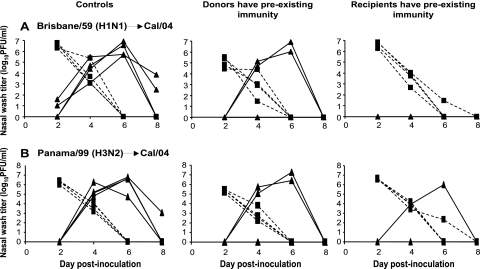FIG. 3.
Previous infection with recent seasonal isolates reduces viral load and limits transmission of Cal/04/09 virus. (A) Transmission of Cal/04/09 virus is reduced from and to guinea pigs with previous exposure to Bris/59/07 (H1N1) virus. (B) Transmission of Cal/04/09 virus is reduced from and to guinea pigs with previous exposure to Pan/99 (H3N2) virus. (Left) Transmission in the absence of preexisting immunity. In each case, naïve animals were productively infected through intranasal inoculation (black squares with dashed lines) and transmitted virus efficiently to contact animals (black triangles with solid lines). (Middle) Transmission from donor guinea pigs with preexisting immunity to a heterologous strain. Four guinea pigs with previous exposure were inoculated intranasally with Cal/04/09 virus. At 24 h postinfection, a naïve guinea pig was placed in the same cage with each inoculated guinea pig. In each case, previously exposed animals were productively infected through inoculation (black squares with dashed lines) but shed lower titers than did previously naïve animals. Transmission to naïve contacts is represented by black triangles with solid lines. (Right) Transmission to recipients possessing preexisting immunity to a heterologous virus. Four naïve guinea pigs were inoculated with Cal/04/09 virus. At 24 h postinfection, a guinea pig previously exposed to the indicated heterologous strain was placed in the same cage with each inoculated guinea pig. In each case, naïve animals were productively infected through inoculation (black squares with dashed lines). Transmission to previously infected contact animals is represented by black triangles with solid lines.

